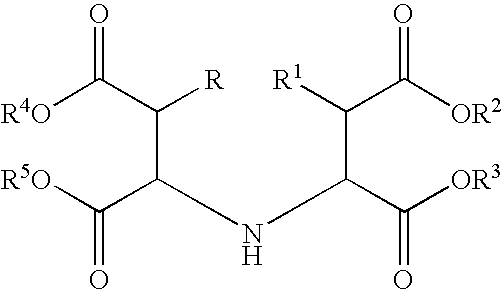Detergent Composition
- Summary
- Abstract
- Description
- Claims
- Application Information
AI Technical Summary
Benefits of technology
Problems solved by technology
Method used
Image
Examples
example 1
Comparative Hard Surface Cleaner Detergent Composition
[0105]Powdered detergent compositions were prepared according to the formulations given in Table 1 below. The compositions comprised the known peroxygen bleach monopersulfate and also the known cyclic sugar ketone bleach activator 1,2:4,5-Di-O-isopropylidene-D-erythro-2,3-hexodiuo-2,6-pyranose (IEHP).
TABLE 1Wt %Component1A1B1C1DSodium Citrate74.873.869.868.8Citric acid2.02.02.02.0Soda0.00.00.00.0IEHP1.02.01.02.0Potassium monopersulphate10.010.015.015.0Amylase*10.40.40.40.4Protease*21.11.11.11.1Sulfonated polymer*35.05.05.05.0PEG 60002.02.02.02.0PEG 15003.03.03.03.0Nonionic Surfactant*40.50.50.50.5Benzotriazole (BTA)0.10.10.10.1Perfume0.10.10.10.1*1DuramylRTM available from Novozymes, Denmark.*2ProperaseRTM ex Genencor International, USA.*3Sulphonated polyacrylic acid copolymer AcusolRTM 587 available from Rohm and Haas.*4C16-18 fatty alcohol 3EO-3PO
[0106]Each separate composition was prepared by simply mixing all the ingredients ...
example 2
Bleaching Capability of Comparative Formulation at pH 7.5
[0107]The bleach performance (and other cleaning performances) of the formulations in Table 1 was tested in a Miele 651 dishwashing machine using a 50° C. normal cycle containing tea cups stained with tea, according to the IKW method described above. 20 g of the powder formulation was added to the dosing chamber of the dishwasher prior to the cycle commencing. The water hardness was 21° gH.
[0108]The results of tea stain bleaching in tea cups obtained by the comparative compositions are given in Table 1. The bleaching effect is expressed on a scale of 1-10 (1 being little or no bleaching and 10 being total bleaching of the tea stain).
TABLE 2pH ofTea StainExampleformulationRemoval1A7.52.91B7.52.91C7.53.01D7.53.0
[0109]The removal of tea stains from tea cups in the above test was insufficient even for the higher concentrations of bleach and bleach activator. The test time in the main wash cycle of the automatic dishwashing cycle (...
example 3
Compositions Comprising Diethyl-aminoacetone Bleach Activator
[0110]Detergent compositions according to the present invention were prepared according to the formulations given in Table 3 below and following the same method as outlined for example 1. The compositions comprised the known peroxygen bleach peroxymonopersulphate and also the diethyl amino acetone bleach activator according to the present invention.
TABLE 3Wt %Component3A3B3CSodium citrate73.871.368.8Citric acid2.02.02.0Soda0.00.00.0Diethyl amino acetone2.02.02.0hydrochloride bleach activatorPotassium monopersulphate10.012.515.0Amylase*10.40.40.4Protease*21.11.11.1Sulfonated polymer*35.05.05.0PEG 60002.02.02.0PEG 15003.03.03.0Nonionic Surfactant*40.50.50.5BTA0.10.10.1Perfume0.10.10.1
[0111]The pH of the formulations was measured at 1 wt % in water at room temperature. Minor amounts of citric acid or soda were added in order to achieve the desired pH value of 7.5.
PUM
 Login to View More
Login to View More Abstract
Description
Claims
Application Information
 Login to View More
Login to View More - R&D
- Intellectual Property
- Life Sciences
- Materials
- Tech Scout
- Unparalleled Data Quality
- Higher Quality Content
- 60% Fewer Hallucinations
Browse by: Latest US Patents, China's latest patents, Technical Efficacy Thesaurus, Application Domain, Technology Topic, Popular Technical Reports.
© 2025 PatSnap. All rights reserved.Legal|Privacy policy|Modern Slavery Act Transparency Statement|Sitemap|About US| Contact US: help@patsnap.com

